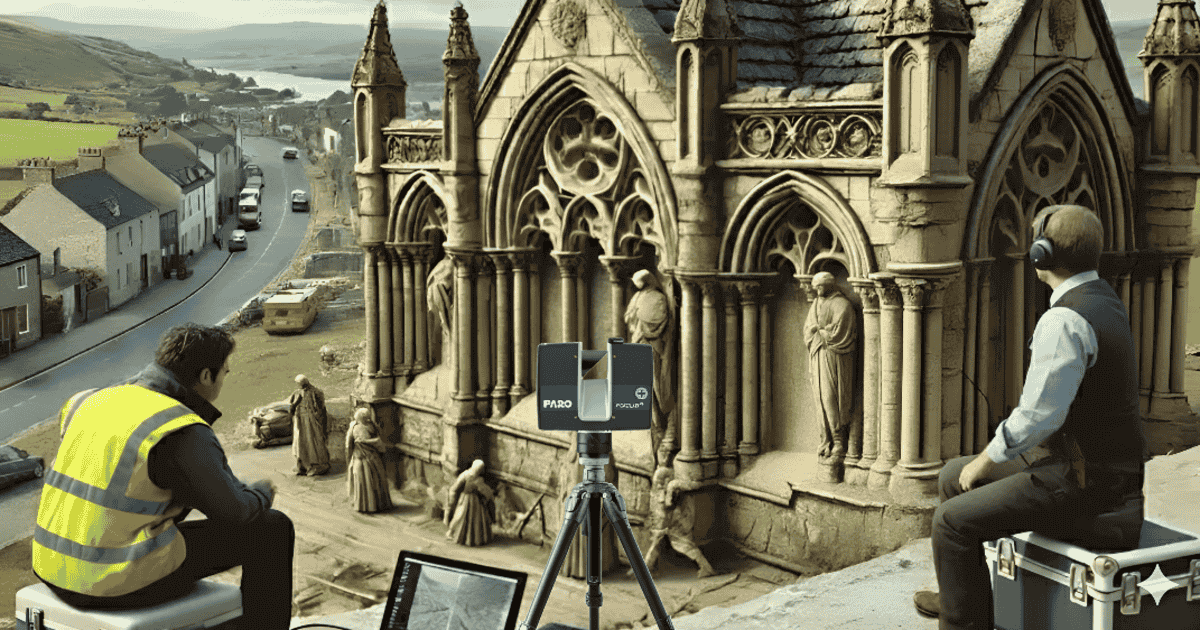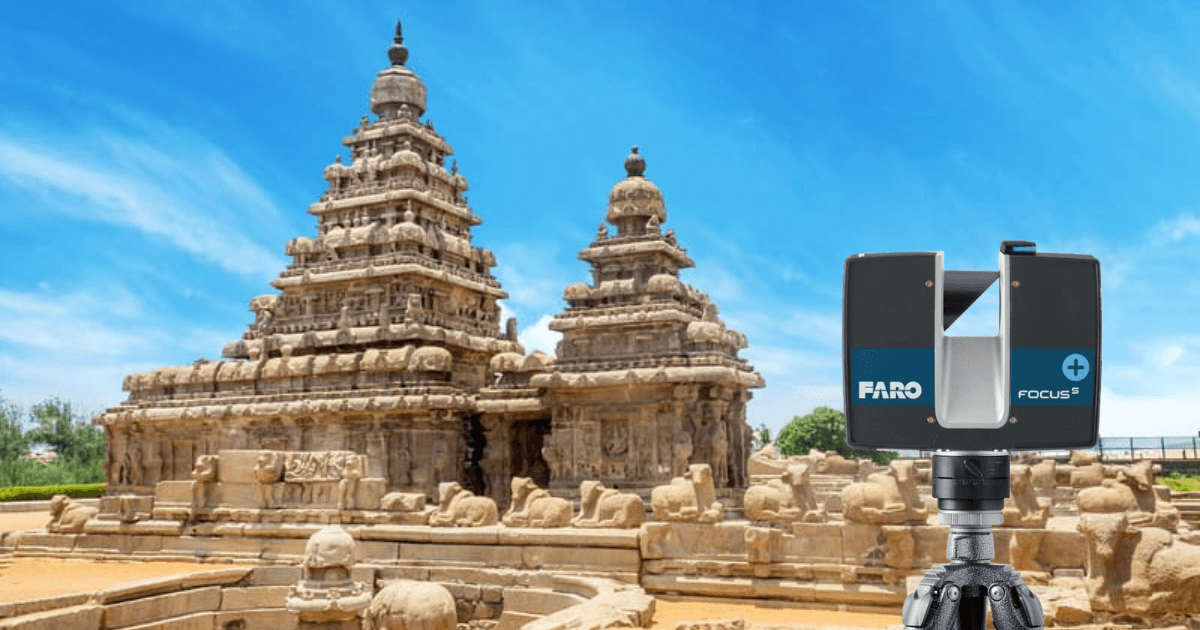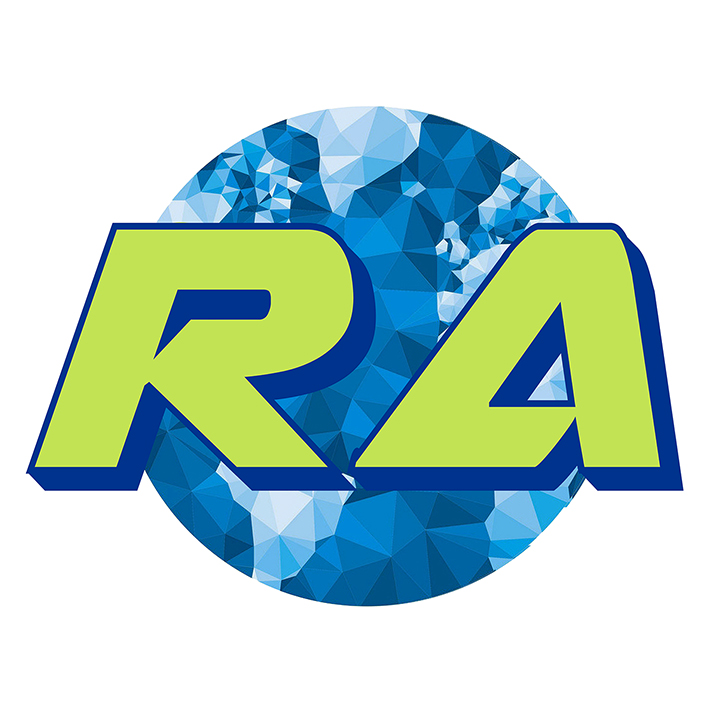Heritage 3D Scanning
What is heritage 3D laser scanning?
3D laser scanning technology is a powerful tool for documenting and preserving heritage buildings, monuments, and artifacts. By capturing intricate details through point cloud laser scanning, we can create a comprehensive database to analyze and monitor the condition of these valuable structures without causing damage. This data enables informed conservation and maintenance plans.
The preservation of cultural heritage sites is becoming increasingly important. To maintain their original heritage value, locations with artistic or heritage significance require meticulous documentation, regular updates, and specialized care. 3D laser scanners like Faro provide a practical and precise means to survey, record, and share spatial information about these sites.
Heritage 3D laser scanning is a cutting-edge technology used to capture the precise geometry and details of heritage objects, buildings, monuments, and sites. This non-invasive method employs 3D laser scanning instruments to collect millions of data points, creating highly accurate 3D digital models. heritage 3D laser scanning is a cutting-edge technology used to capture the precise geometry and details of heritage objects, buildings, monuments, and sites. This non-invasive method employs laser scanning instruments to collect millions of data points, creating highly accurate 3D digital models.
Why is 3D laser scanning in heritage important?
- Accurate Documentation: It creates highly detailed digital models of heritage structures, capturing intricate details and measurements with precision. This helps in preserving the architectural integrity and heritage significance of the site.
- Restoration and Conservation: 3D scanning enables experts to study the structural health of heritage buildings, identify areas of damage, and develop targeted restoration plans. This ensures that any interventions align with the original design and preserve the heritage features.
- Non-Invasive Assessment: 3D laser scanning is a non-invasive technique that does not require physical contact with the structure, minimizing the risk of damage to fragile or sensitive areas.
- Digital Archiving: The resulting 3D models serve as a permanent digital record of the structure, providing a valuable resource for future preservation efforts, research, and education.
Benefits of 3D laser scanning in heritage:
- Rapid and accurate virtual copy generation, meticulous information and 3D documentation, and complex structural 3D imaging and modeling at your fingertips
- Representation of actual 3D digital designs of cultural heritage when they are out of date.
- Showcase, record, and restore sacred sculpture and intricate carvings in caves or in ancient temples.
- 3D Documentation of a ‘Vanishing’ Civilization
- Site Survey, assessments of cultural assets and preservation of heritage artefacts
- It Aids in preserving a piece of Indian culture
- Ancient City can be Preserved in Digital Scans
- Cave exploration and documentation
Common challenges in 3D laser scanning for heritage include:
- Data Complexity: Integrating multiple technologies to capture diverse elements of heritage gardens, such as architectural features, vegetation, and topography, can be complex.
- Dynamic Landscapes: Heritage gardens are living monuments that change over time due to vegetation growth, climatic fluctuations, and management decisions, making it challenging to capture accurate data.
- Environmental Factors: Environmental degradation, urban development pressures, and natural disasters pose significant threats to heritage gardens, highlighting the need for comprehensive disaster risk management and consistent maintenance efforts.
- Preservation and Conservation: Ensuring the long-term preservation and management of cultural heritage assets requires detailed management plans, thorough research, and documentation using modern technologies.

Related Services
The following services are commonly offered along with 3D laser scanning for heritage preservation:
- High-Resolution 3D Laser Scanning: Captures detailed digital documentation of heritage buildings and landmarks
- Scan to BIM for Heritage Sites: Integrates 3D scan data into Building Information Modeling (BIM) for informed architectural planning and renovation design
- Drone Services: Utilizes drones for capturing data and creating detailed models of heritage sites
- Digital Twins for Asset Management: Creates digital replicas of heritage sites for long-term preservation and management
- 2D CAD Drawings & Floor Plans: Generates accurate 2D drawings and floor plans from 3D scan data
Working of 3D laser scanning in heritage
3D laser scanning is a precise technology used to capture the intricate details of objects or surfaces. The process involves three key steps: 3D laser scanning, data collection, and data processing.
- 3D Laser Scanning: A 3D laser scanner emits beams that bounce off the target object or surface. These beams measure distances and capture intricate details, including: The 3D laser scanner calculates the distance between the scanner and the object's surface; the laser beams capture fine details, such as textures, patterns, and geometries.
- Data Collection: The scanner collects data points, creating a dense point cloud that represents the object's surface geometry. The point cloud is a collection of points; each point represents a specific location on the object's surface, and the data points contain accurate spatial information, including x, y, and z coordinates.
- Data Processing: Specialized software processes the point cloud data, generating a precise 3D digital model. The software aligns and registers the data points to create a cohesive point cloud; the software filters out noise and cleans the data to ensure accuracy; the software generates a precise 3D digital model, capturing the object's surface geometry and details.

What are the applications of 3D laser scanning in heritage across various industries?
3D laser scanning has numerous applications in heritage preservation across various industries, including:
- Heritage Preservation: Documenting heritage sites and artifacts with high precision to create detailed digital records for restoration, conservation, and education purposes.
- Architectural Heritage Preservation: Creating detailed 3D models of heritage buildings to capture intricate architectural details, styles, and designs for restoration and remodeling projects.
- Archaeology: Digitizing tangible artifacts like fossils and sculptures to create 3D digital models for analysis, preservation, and education.
- Museum and Art Conservation: Preserving delicate artifacts and fossils in 3D digital form for documentation, analysis, and global sharing.
- Restoration and Conservation: Providing detailed point cloud data and 3D models for restoration projects, enabling precise planning and execution.
- Education and Research: Creating digital archives of heritage sites and artifacts for educational purposes, facilitating global access and appreciation of cultural heritage.
- Documentation and Archiving: Capturing detailed 3D geometry of heritage objects and sites for permanent digital archiving.
Why Choose RA Global?
RA Global is a reliable choice for 3D laser scanning and as-built modeling services due to their expertise, advanced technology, and commitment to quality. With extensive experience in providing industry-leading services to various sectors, including aerospace, automotive, and heritage preservation, we utilize cutting-edge 3D scanning technologies to deliver high-resolution 3D models and point clouds.
- Expertise: experienced team with a proven track record.
- Accuracy: high-precision 3D laser scanning technology.
- Customization: tailored solutions for your specific needs.
- Timely delivery: efficient project management and delivery.
Contact us to learn more about how we can deliver the best possible results for your heritage preservation.
Frequently Asked Questions
What is 3D laser scanning in heritage?
3D laser scanning captures precise shapes and dimensions of objects or spaces, creating digital 3D models.
Why is 3D laser scanning used in heritage preservation?
3D laser scanning is used in heritage preservation for documentation, conservation, research, virtual exhibitions, and accessibility, enabling detailed records, precise restoration, and wider audience engagement.
What are some challenges associated with 3D laser scanning in heritage?
Challenges of 3D laser scanning in heritage include environmental factors, data processing complexities, high costs, and ethical considerations.
Why choose RA Global for 3D laser scanning in heritage?
RA Global offers expertise in 3D laser scanning and as-built documentation services.
What is heritage documentation?
Heritage documentation is the process of systematically capturing, recording, and preserving data on heritage sites and buildings, including their physical, historical, and cultural aspects, for future generations.

